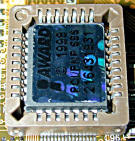


|
 --------------------------------------------------------------------------------------------------------------------------------- 1. Set the Boot Sequence to boot from the drive where Windows is installed 2. Disable ‘PCI/VGA Palate Snoop’, unless you have a very old PCI 2D accelerator card. 3. Disable ‘Video BIOS Shadow’. 4. Enable Shadow System BIOS—see if it increases performance for your system, otherwise disable it 5. Disable ‘Video BIOS Cacheable’—as most new video cards do not need this 6. Enable ‘Video RAM Cacheable’—only if you have older cards, Disable it for newer cards with more than 16 MB RAM 7. Set ‘8 & 16 bit I/O Recovery Time’ to 0 or N/A—if you do not use ISA cards. 8. Enable ‘SDRAM Precharge Control’—unless it causes problems with your system 9. Set the CAS Latency Time to 2 for fastest performance. This sets the time delay before the SDRAM starts to carry out a read command 10. Set the RAS-to-CAS Delay to 2T. This inserts a delay between the RAS (Row Address Strobe) and CAS (Column Address Strobe) signals  12. Disable ‘Memory Hole’. 13. Disable ‘Passive Release’ 14. Disable ‘Delayed Transaction’ 15. Choose PCI or AGP for ‘Init Display First’, as per your display card. 16. Set the KBC Input Clock to 16 MHz. This setting has to do with the Super I/O chip 17. The AGP Aperture size determines how much of your system RAM is shared with your graphics card, to help it function smoothly. Set it according to the amount of RAM on your system: If you have 128 MB or more, set it to 64 MB or 32 MB. For those with less than 128 MB RAM, set this to half or quarter the amount of RAM you have—if you have 96 MB of RAM, set this to 48 MB or 24 MB, etc. make sure to allot at least 16 MB to the graphics card. --------------------------------------------------------------------------------------------------------------------------------- -------------------------------------------------------------------------------------------------------------------------------- Sometimes, even after programs are uninstalled, or due to the files being deleted instead of a uninstalled, the entry in the Add/Remove Programs list does not get deleted. To remove it from the list: 1. Start the Registry Editor. 2. Open HKEY_LOCAL_MACHINE\SOFTWARE\Microsoft\Windows\CurrentVersion\Uninstall. 3. Delete the program entry here. -------------------------------------------------------------------------------------------------------------------------------- -------------------------------------------------------------------------------------------------------------------------------- If you have 24MB or more RAM, you can optimise performance by selecting Network server as the typical role of your computer. 1. Open Control Panel > System > Performance > File System. 2. On the Hard Disk Tab, select Network Server as Typical role of this computer. The setting you use controls the size of various internal data structures used by the 32-bit file access driver (VFAT). When you use the Mobile Or Docking System setting, VFAT allocates memory to record the 16 most recently accessed folders and the 337 most recently accessed files. This consumes approximately 4KB of memory. When you use the Desktop Computer setting, VFAT allocates memory to record the 32 most recently accessed folders and the 677 most recently accessed files. This consumes approximately 8KB of memory. When you use the Network Server setting, VFAT allocates memory to record the 64 most recently accessed folders and the 2729 most recently accessed files. This consumes approximately 16KB of memory. -------------------------------------------------------------------------------------------------------------------------------- -------------------------------------------------------------------------------------------------------------------------------- Courtesy to Geocities.com |